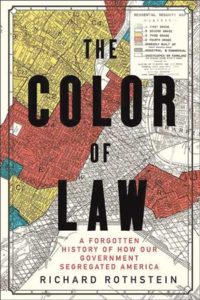The Color of Law: A Forgotten History of How Our Government Segregated America
Reviewed by David Breitzmann
January 1, 2018
 By Richard Rothstein. Liveright, 2017. 368 pages. $27.95/hardcover; $17.95/paperback (May 2018); $26.23/eBook.
By Richard Rothstein. Liveright, 2017. 368 pages. $27.95/hardcover; $17.95/paperback (May 2018); $26.23/eBook.
The title of this fascinating analysis of racialized public policy is a double entendre that refers to the appearance of legality for a policy or legislative act (the very implementation of which undermines human dignity and value) and which points out that U.S. law has been used in the service of racial segregation. Legal status cannot make morally right that which is not. In The Color of Law, Richard Rothstein of the Economic Policy Institute meticulously explores a nexus of local, state, and federal public policy as the origin of hostility between distinct ethnic communities. Rothstein challenges the misconception that laws reflect already existing biases in a given community. Instead, Rothstein argues that housing policies created racial hostilities in communities where they hadn’t previously existed. The premise for such policies was that an African American presence in formerly white neighborhoods would inevitably devalue property prices.
Rothstein persuasively argues that the federal government served as the oxygen that both lit and kept burning these racially charged flames. This book explores a wide canvas of institutional actors—the Veterans Administration, the Federal Housing Administration (FHA), and the U.S. military—that acted explicitly to prevent housing developments from being accessible to African Americans. The federal government also excluded African Americans from wartime skilled labor and denied African American veterans the educational advancement that they were promised upon entering military service. The background for these twentieth-century policies is historical law of the United States, which economically benefited some through devaluing African Americans as less than human beings. Rothstein sets the scene for where this leaves us: the current median household wealth is $134,000 for whites and $11,000 for African Americans.
Policies following wartime also evidence economic injustice. These include the traditional, multi-decade, amortized mortgage and requisite FHA insurance. Rothstein points out that home ownership was deployed by the administration of President Wilson after the 1917 Russian Revolution as a mechanism to suture Americans to the capitalist (as opposed to communist) system. To this end, the federal government of the 1930s, through the Home Owners’ Loan Corporation Act, actually purchased existing home mortgages that were in danger of default. The underwriting guidelines which directed the financing decisions of real estate agents were explicitly constructed to maintain current (read all-white) neighborhood social compositions.
At the local level, many practices deliberately worked to socially engineer all-white neighborhoods. These included changing zoning ordinances, inserting restrictive covenants into deeds, changing minimum lot size for developments, altering property assessment practices, and organizing mass protests as reprisals should an African American family move into a neighborhood. Rothstein cites several examples of local housing projects from which African Americans were barred. In Levittown, Pennsylvania, 17,500 homes were sold for $8,000 with no down payment required. The project did not have a single African American buyer.
An underwhelming element in this book is Rothstein’s acceptance of various normative frameworks. This is troubling given that he explicitly states that policies to remedy housing discrimination are far more challenging than are those that alter other discriminatory practices, such as preventing access to the ballot box or lunch counter. Rothstein mentions in passing that it is hard to argue against the idea that all other considerations–including racial equality–needed to be subordinated to winning World War II. Is it not true that such an express policy limits support for a host of other public policies, including housing? Are we not currently at war? How would such an argument impact the needed support for any forthcoming housing policy suggestions? Rothstein also seems reluctant to move beyond the role of critic in order to offer a restorative housing policy blueprint. Rothstein tentatively suggests (as “recovery” rather than “reparations”) below-market sales of houses to African Americans. He seems so firmly attached to market-based doctrine that he offers a prescription that would very likely do exactly what anxious whites feared: lower property values. Such depressed prices would then lead to white flight and ultimately foster the growth of additional black ghettos. Rothstein’s views of housing as an individually owned, accumulative commodity seem particularly unsuited to challenging contemporary economic doctrine (as it implies fiduciary decision making) if and when needed. This contrast is particularly glaring given the systemic imbalances so evident after the Great Recession. Rothstein is quite satisfying as an investigative critic but not nearly as convincing as a prophetic voice calling for a housing policy that leads to restorative social justice. This book would benefit greatly from an expanded epilogue that included a more wide-ranging exploration of proposals such as those laid out in The Resilience Imperative by Michael L. Lewis and Pat Conaty.



Comments on Friendsjournal.org may be used in the Forum of the print magazine and may be edited for length and clarity.